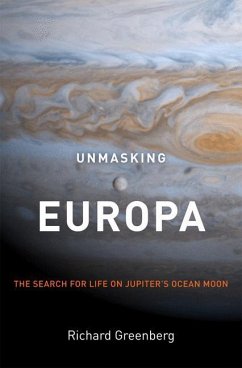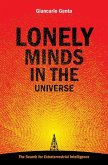In Unmasking Europa, Richard Greenberg tells the story of how he and his team of researchers came to believe that the surface of Europa is in fact a crust so thin and active that it can barely hide an ocean of liquid water below. He shows how this ocean is warmed by the friction of tidal movements in this small moon as it revolves while at the same time orbiting immense Jupiter, and how those tides drive all the activity in evidence on the surface. The implications of this interpretation-which includes the idea that there are active intermittent openings from the liquid ocean to the frozen surface-are immense. The warmth, the chemistry, and the connections from ocean to surface provide the conditions necessary for the existence of life, even at this relatively remote locale in our solar system, far beyond what's normally thought of as its "habitable zone."
Unmasking Europa describes in clear but technically accurate terms-and with extensive illustrations (including more than 100 NASA mission images)-the remarkable history of research on Europa over the last four decades. The book also provides unique insights into how "big science" gets done today, and it is not always a pretty picture. From his perspective as a Professor of Planetary Sciences at the University of Arizona, and a quarter-century-long membership on the Imaging Team for the Galileo space mission, Greenberg describes how personal agendas (including his own) and political maneuvering (in which he received an education by fire) determined a lot about the funding, staffing, and even the direction of research about Europa.
While he is satisfied that his team's work is now, finally, receiving fair consideration and even respect, Greenberg comes away from his decades-long experience feeling that something is fundamentally wrong with the scientific enterprise as a whole because it routinely punishes innovation, risk-taking thought, and a willingness to simply letthe evidence lead where it may. In today's scientific culture, with its careerist pressures and peer-reviewed propriety, Greenberg believes, astute scientists (and sadly many of our youngest and brightest scientists) quickly realize that the most rewarding research strategy is to stay within the mainstream-a tendency that by its very nature is at odds with the ideals of scientific investigation and thought.
Unmasking Europa describes in clear but technically accurate terms-and with extensive illustrations (including more than 100 NASA mission images)-the remarkable history of research on Europa over the last four decades. The book also provides unique insights into how "big science" gets done today, and it is not always a pretty picture. From his perspective as a Professor of Planetary Sciences at the University of Arizona, and a quarter-century-long membership on the Imaging Team for the Galileo space mission, Greenberg describes how personal agendas (including his own) and political maneuvering (in which he received an education by fire) determined a lot about the funding, staffing, and even the direction of research about Europa.
While he is satisfied that his team's work is now, finally, receiving fair consideration and even respect, Greenberg comes away from his decades-long experience feeling that something is fundamentally wrong with the scientific enterprise as a whole because it routinely punishes innovation, risk-taking thought, and a willingness to simply letthe evidence lead where it may. In today's scientific culture, with its careerist pressures and peer-reviewed propriety, Greenberg believes, astute scientists (and sadly many of our youngest and brightest scientists) quickly realize that the most rewarding research strategy is to stay within the mainstream-a tendency that by its very nature is at odds with the ideals of scientific investigation and thought.
From the reviews:
"Unmasking Europa ... brings you face to face with the surface scars of this tiny Jovian moon and tells the story of how our scientific understanding of this enigmatic world has developed. ... Through clear descriptions of unfamiliar terms, usefully annotated diagrams, and beautiful colour plates, the story of Europa is made accessible to anyone, even without a prior knowledge of planetary science." (Emily Baldwin, The Observatory, Vol. 129 (1210), June, 2009)
"The icy crust of Jupiter's moon Europa, cut by dramatic faults and other irregularities, caps a hidden ocean about 100 kilometers deep. Greenberg (planetary sciences, Univ. of Arizona) believes the crust is relatively thin ... . his explanations of how tides influenced the Europan crust are generally elegant and interesting. The book includes a few Web sites with images of Europa. Summing Up: Recommended. Lower- and upper-division undergraduates, two-year technical program students, and general readers." (B. M. Simonson, Choice, Vol. 46 (8), April, 2009)
"The book is a very clear and accessible exposition of the Europa observations, and of how movements of the ice crust could have produced them. ... the author is gratified that his 'thin-ice' model of Europa is now gaining credence, which may well indicate, as he believes, that correct arguments must ultimately win over the scientific community. ... this book can be recommended as a good non-technical synopsis of our present understanding of the satellite ... ." (Journal of the British Astronomical Association, April, 2009)
"It is written by Richard Greenberg ... . His arguments that the thick ice interpretation on Europa is flawed sound convincing ... . The new book is stripped of much of the mathematical and geologic terminology used in the original in order to reach a wider audience. ... the author is spending more time describing the process of discovery of Europa's secrets." (UnmannedSpaceflight, October, 2008)
"Centauri Dreams readers already know of my admiration for Richard Greenberg's ... Unmasking Europa: The Search for Life on Jupiter's Ocean Moon(Copernicus). It's a lively and challenging book, one which Greenberg used to take sharp issue with many of his colleagues, and ... when I reviewed the book, the animated back and forth makes for a fascinating look at how planetary science gets done. ... Read Unmasking Europa for a close look at the Europan surface as seen through Voyager and Galileo imagery ... ." (Centauri Dreams, October, 2009)
"This book ... recounts the fierce friction between the personalities leading the Galileo mission and publishing their interpretations of what they saw. ... the story-telling is first-rate and elegantly explains not just the processes at work on this intriguing little world but also the rivalries and political manoeuvring of Big Science. ... Unmasking Europa is a gripping story of the exploration of a new world and the often heated debates within science, and is absolutely stuffed with gorgeous images of strange Europan landscapes." (Lewis Dartnell, Astrobiological Society of Britain, March, 2009)
"Unmasking Europa ... brings you face to face with the surface scars of this tiny Jovian moon and tells the story of how our scientific understanding of this enigmatic world has developed. ... Through clear descriptions of unfamiliar terms, usefully annotated diagrams, and beautiful colour plates, the story of Europa is made accessible to anyone, even without a prior knowledge of planetary science." (Emily Baldwin, The Observatory, Vol. 129 (1210), June, 2009)
"The icy crust of Jupiter's moon Europa, cut by dramatic faults and other irregularities, caps a hidden ocean about 100 kilometers deep. Greenberg (planetary sciences, Univ. of Arizona) believes the crust is relatively thin ... . his explanations of how tides influenced the Europan crust are generally elegant and interesting. The book includes a few Web sites with images of Europa. Summing Up: Recommended. Lower- and upper-division undergraduates, two-year technical program students, and general readers." (B. M. Simonson, Choice, Vol. 46 (8), April, 2009)
"The book is a very clear and accessible exposition of the Europa observations, and of how movements of the ice crust could have produced them. ... the author is gratified that his 'thin-ice' model of Europa is now gaining credence, which may well indicate, as he believes, that correct arguments must ultimately win over the scientific community. ... this book can be recommended as a good non-technical synopsis of our present understanding of the satellite ... ." (Journal of the British Astronomical Association, April, 2009)
"It is written by Richard Greenberg ... . His arguments that the thick ice interpretation on Europa is flawed sound convincing ... . The new book is stripped of much of the mathematical and geologic terminology used in the original in order to reach a wider audience. ... the author is spending more time describing the process of discovery of Europa's secrets." (UnmannedSpaceflight, October, 2008)
"Centauri Dreams readers already know of my admiration for Richard Greenberg's ... Unmasking Europa: The Search for Life on Jupiter's Ocean Moon(Copernicus). It's a lively and challenging book, one which Greenberg used to take sharp issue with many of his colleagues, and ... when I reviewed the book, the animated back and forth makes for a fascinating look at how planetary science gets done. ... Read Unmasking Europa for a close look at the Europan surface as seen through Voyager and Galileo imagery ... ." (Centauri Dreams, October, 2009)
"This book ... recounts the fierce friction between the personalities leading the Galileo mission and publishing their interpretations of what they saw. ... the story-telling is first-rate and elegantly explains not just the processes at work on this intriguing little world but also the rivalries and political manoeuvring of Big Science. ... Unmasking Europa is a gripping story of the exploration of a new world and the often heated debates within science, and is absolutely stuffed with gorgeous images of strange Europan landscapes." (Lewis Dartnell, Astrobiological Society of Britain, March, 2009)








